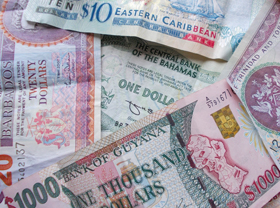Caribbean struggles to escape downturn

By Tony Fraser, writing from Bridgetown
The people of the English-speaking Caribbean will have to face continued slow economic growth in 2013, the Caribbean Development Bank (CDB) has forecasted.
The CDB released its annual report in February predicting a continuation of the last four to five years of widespread decline, including job losses.
CDB President Warren Smith outlined the bleak picture at a news conference held at the Barbados headquarters of the regional development project lending bank.
The 18 core borrowing members of the CDB “struggled to find their economic footing in 2012”, the Jamaican-born economist and bank head explained to journalists.
Growth for some
The CDB data shows a marginal growth rate of 1% last year for member states. This compares with 1.2% growth in 2011.
“The growth momentum stalled in nine of CDB’s borrowing member countries, with six recording actual decreases in economic activity,” said Dr Smith.
In addition to the 18 borrowing member Caribbean countries, non-borrowing members of the CDB are Venezuela, Colombia, Mexico, Canada, China, Germany, the UK and Germany.
Belize, a member of the Caribbean Community located in Central America, and Guyana, in continental South America, were the region’s two top performers in 2012, registering growth levels above 3%.
In Belize, agricultural production was mainly responsible for growth, while mining activities in bauxite and gold were the major drivers of economic growth in Guyana.
Also on the growth list were:
- The Bahamas – tourism and construction
- The British Virgin Islands – tourism and the offshore sector
- Haiti – all sectors except for agriculture
- Trinidad and Tobago – a strong performance in service sectors such as finance, distribution, restaurants and hotels
Among those countries where economic activity declined last year were Antigua, Dominica, Grenada, St Lucia, Montserrat and Jamaica.
Manufacturing and tourism
The CDB president says that weak demand for goods and services, the fall-off in private sector investment and the reduction by governments in spending on capital programmes were the major causes of the economic decline.
Manufacturing across the region “struggled to remain competitive”.
The strongest regional manufacturer, Trinidad and Tobago, suffered because of “sluggish regional demand and disruptions in production because of several industrial disputes”.
In the vital tourism sector, there were increases in arrivals in the Bahamas [2.9%] and Jamaica [2.3%], with similar levels of growth in Antigua/Barbuda and significant increases in visitor arrivals in Belize [10.1%] and Guyana [17.2%].
However, there were declines in Grenada, Anguilla, Barbados, Anguilla and St Lucia.
That weak economic performance has destroyed large numbers of jobs.
By the year’s end, unemployment had reached 14.7% in the Bahamas and 12.2% in Barbados, while in St Lucia, people without jobs amounted to 21.2% of the working population, said the CDB report.
Global links
Looking to 2013 and beyond, the CDB president predicted improvement in tourism figures, while growth in the region would be “positive for the most part”.
He said that, with global growth expected to creep up to 3.5% and given that the economies of Caribbean countries were very dependent on the outside world, this would provide more tourists and foreign direct investment, which had declined in 2012.
In tourism-based economies, the CDB said countries needed to give careful attention to attracting major airlines to the Caribbean, as well as promoting their tourism offer in traditional and new markets.
ADVERTISEMENT
At the same time, the CDB president is concerned about increasing debt levels, which range from 85% to more than 100% of GDP in Jamaica and several Eastern Caribbean countries.
The bank said that improvement in productivity levels to compete with the rest of the world would be a major requirement for the future.
Amid the difficulties of 2012, the CDB agreed loans to member countries amounting to US$104m, down from US$144m in 2011.
Actual disbursement of loans in 2012 amounted to only US$85m, as against US$167m in 2011.
“The Bank’s performance reflects the difficult macroeconomic and fiscal environment in the regional and international economy,” said Dr Smith.
The CDB president is banking on accessing international development funding to counter economic and social setbacks caused by annual hurricanes and floods.
The Caribbean Growth Forum should also have a positive role to play, as an institution that brings together investors, regional business organisations and policymakers to discuss economic possibilities.
Nonetheless, a major concern is the lack of progress in establishing and implementing the full Caricom Single Market and Economy [CSME].
The CSME is seen by Caribbean leaders, economists and regional planners as the engine needed to drive fundamental economic development in the Caribbean.
Waiting for the full single economy
The Single Market initiative has already had some results: a degree of free movement of skilled workers across the region, hassle-free travel and the adoption of a common external tariff on goods from third countries.
However, there is still foot-dragging over the introduction of a Single Economy, that would combine the resources of member states to produce Caribbean goods and services as one country for export.
At stake is the Caribbean’s chance to end centuries of being low-cost raw material producers for the rest of the world, while consuming high-cost finished products from the industrial world.
On behalf of Caribbean Intelligence©, I put several specific questions to the CDB president on the question of the CSME, the lack of progress and the consequent negative impact on Caribbean economic growth and development.
Here’s the transcript of that particular Q&A:
“I frankly will not have the time this morning to begin to talk about the problems of the CSME,” Dr Smith said, “but I am sure that politics looms large.
“We can learn from the lessons of the Organisation of Eastern Caribbean States and the regional nature of institutions amongst the OECS. The hope is that they [integrated institutions] will inspire Caribbean leaders to come together under the CSME.”
Tony Fraser: “Is it that Caricom (the political leaders/governments) need to create the institutional infrastructure to allow the private sector to integrate production across the region; or is it, as has often been charged, that the private sector lacks entrepreneurship and is averse to risk-taking?”
Dr Smith: “The private sector is way ahead of the governments and politicians. What we need at the multilateral level are proper structures in place for the private sector to develop cross-border investment ventures.
“The objective reality is the need for the spread of the logistics and the integration of financial policies, the coordination of regulation.”
Tony Fraser: “But are you satisfied that there is sufficient spirit of entrepreneurship in the private sector for the task ahead?”
Dr Smith: “Perhaps there is not sufficient, but the spirit is there. The recent introduction by the CXC [the Caribbean Examination Council – the body which sets curricula for the secondary school system across the English-speaking Caribbean] of a subject in entrepreneurship could develop capacity. Youth and women could play a major role in the development of higher levels of entrepreneurship.”
Tony Fraser: “Do you think there is need for political change in the Caribbean for advances to be made; and here I am not talking about changing political parties in office, but rather a change in the political orientation; as you know, it is politics which drives the economics?”
Dr Smith: “I don’t want to go there. All I would say is that policies and programmes are important, that is all I would want to say on that. I understand where you want to take me but I am not willing to go there.”


